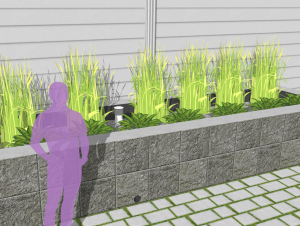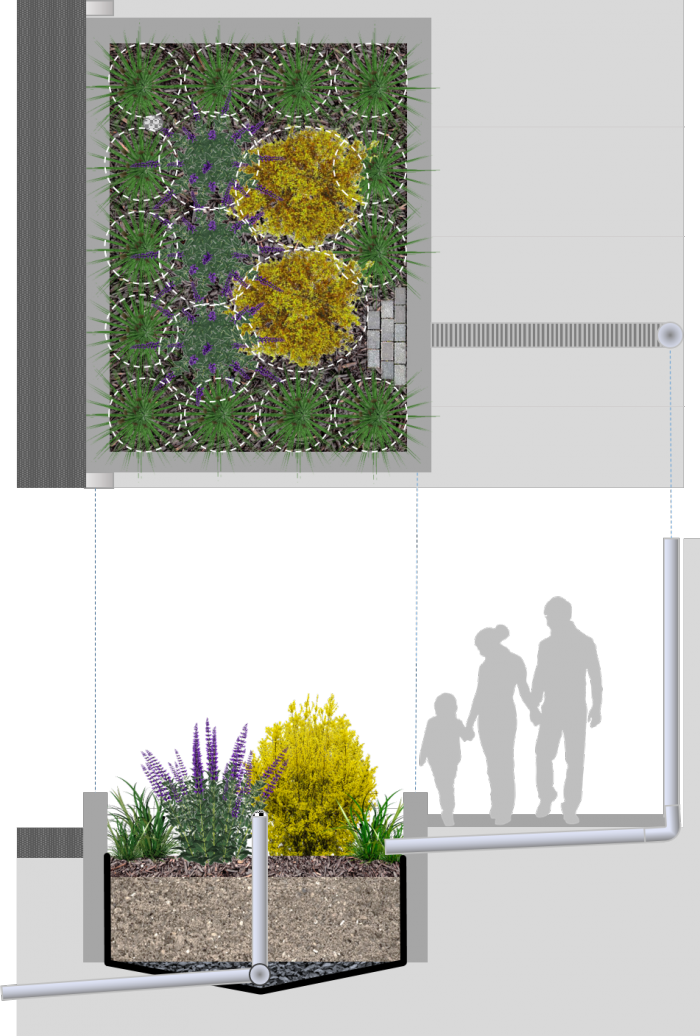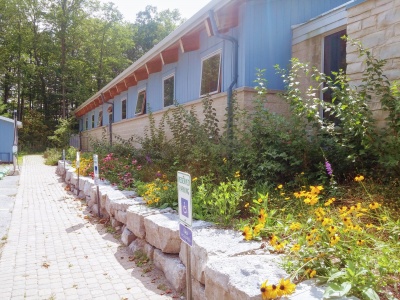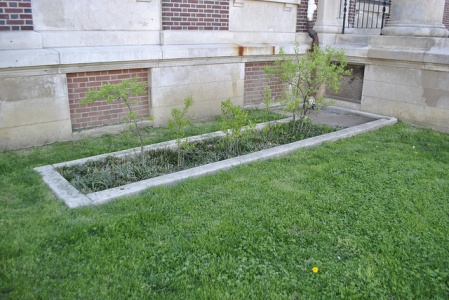Difference between revisions of "Stormwater planters"
Jenny Hill (talk | contribs) m (→Underdrain) |
Jenny Hill (talk | contribs) m |
||
| Line 12: | Line 12: | ||
rect 188 1298 156 1071 [[Overflow]] | rect 188 1298 156 1071 [[Overflow]] | ||
rect 200 1118 498 1146 [[Mulch]] | rect 200 1118 498 1146 [[Mulch]] | ||
| − | |||
| − | |||
| − | |||
| − | |||
rect 152 1166 340 1189 [[mulch]] | rect 152 1166 340 1189 [[mulch]] | ||
| Line 27: | Line 23: | ||
rect 369 972 483 1162 [[Shrubs]] | rect 369 972 483 1162 [[Shrubs]] | ||
poly 139 1158 149 1155 151 1303 352 1343 542 1305 541 1165 550 1161 553 1311 354 1355 139 1311 [[Liner]] | poly 139 1158 149 1155 151 1303 352 1343 542 1305 541 1165 550 1161 553 1311 354 1355 139 1311 [[Liner]] | ||
| + | </imagemap> | ||
| − | |||
Over subsurface infrastructure, soils prone to subsidence, or pollution hotspots, it may be necessary to prevent all [[infiltration]]. These BMPs can also be squeezed into tight urban spaces, adjacent to buildings and within the usual setbacks required for infiltrating facilities. Stormwater planters can also be used as a means of providing building-integrated LID by capturing a portion of the rainwater from the rooftop. | Over subsurface infrastructure, soils prone to subsidence, or pollution hotspots, it may be necessary to prevent all [[infiltration]]. These BMPs can also be squeezed into tight urban spaces, adjacent to buildings and within the usual setbacks required for infiltrating facilities. Stormwater planters can also be used as a means of providing building-integrated LID by capturing a portion of the rainwater from the rooftop. | ||
This type of cell can be constructed above grade in any waterproof and structurally sound container, e.g. in cast concrete or a metal tank. | This type of cell can be constructed above grade in any waterproof and structurally sound container, e.g. in cast concrete or a metal tank. | ||
| Line 47: | Line 43: | ||
==Design== | ==Design== | ||
| − | + | {{:Planters:Sizing}} | |
| − | |||
===Storage media=== | ===Storage media=== | ||
Revision as of 17:27, 19 March 2018
Over subsurface infrastructure, soils prone to subsidence, or pollution hotspots, it may be necessary to prevent all infiltration. These BMPs can also be squeezed into tight urban spaces, adjacent to buildings and within the usual setbacks required for infiltrating facilities. Stormwater planters can also be used as a means of providing building-integrated LID by capturing a portion of the rainwater from the rooftop. This type of cell can be constructed above grade in any waterproof and structurally sound container, e.g. in cast concrete or a metal tank.
Overview[edit]
Stormwater planters are an ideal technology for:
- Sites which cannot infiltrate water owing to contaminated soils or shallow bedrock,
- Zero-lot-line developments such as condos or dense urban infill.
The fundamental components of a stormwater planter are:
- a planting bed of storage media,
- suitable vegetation,
- decorative aggregate or stone,
- An underdrain
The design may benefit from:
Planning Considerations[edit]
Design[edit]
Storage media[edit]
Underdrain[edit]
Stormwater planters differ fundamentally from bioretention in that the storage function is provided only by the water retention capacity of the filter media. As such there is no storage reservoir and the only purpose to the aggregate layer is to drain water to the perforated pipe. For this, a medium aggregate as described in choker layer is recommended as it negates the need for a separating layer to the filter media. Underdrain
Planting[edit]
Stormwater planters routinely capture only rainwater flowing from adjacent rooftops. This means that salt may be less of a concern than in Bioretention: Parking lots or Bioretention: Streetscapes. The plant lists are still a good place to start when selecting species for LID in Ontario.
Liners[edit]
An impermeable liner is incorporated into non-infiltrating practices such as stormwater planters, and may be applied in permeable pavements installations where separation from the native soils and groundwater is required.
- Waterproof containment can be created using concrete or a plastic membrane/liner (HDPE or EPDM are common materials).
- When the membrane is being used directly in the ground, punctures from stones can be prevented by compacting a layer sand (30 - 50 mm) over the soil prior to installing the membrane.
- Alternatively, a manufactured cushion fabric (geotextile) can be employed for this purpose.
- The top surface of the membrane must also be protected from stone and gravel being used for inside the BMP. Again, sand or a cushion fabric may be used.
- When a pipe is used to provide drainage from the practice to an outlet structure or storm sewer, a 'pipe boot' or flange should be sealed to both the pipe and the liner to prevent leaks.
Surface[edit]
As stormwater planters are often quite small and receive very rapid flow, both a level spreader and the use of stone mulch are strongly recommended.
Gallery[edit]
Stormwater planters are ideal for situating alongside buildings to capture rainwater from roof runoff. LSRCA headquarters, 2017.
Stormwater planter, treating downspout runoff, at Waterview Rec Center, Philidelphia
Photo credit: PWDRain garden, Illick Hall, SUNY College of Environmental Science and Forestry, Syracuse, NY
Photo credit: DASonnenfeld
Performance[edit]
|
Starting after TRIECA (end March) members of STEP will be undertaking a literature review on the performance of our most popular BMPs. The results will be combined with the information we have to date from the development of the Treatment Train Tool and agreed performance metrics established. Until then, please feel free to continue to ask questions via email or the feedback box below. |
See Also[edit]
Proprietary links[edit]
A number of precast modules exist to contain treatment media. As many of these systems are enclosed water balance calculations may be erroneous where evapotranspiration is constrained.
In our effort to make this guide as functional as possible, we have decided to include proprietary systems and links to manufacturers websites.
Inclusion of such links does not constitute endorsement by the Sustainable Technologies Evaluation Program.
Lists are ordered alphabetically; link updates are welcomed using the form below.
- ↑ Macnamara, J.; Derry, C. Pollution Removal Performance of Laboratory Simulations of Sydney’s Street Stormwater Biofilters. Water 2017, 9, 907.;doi:10.3390/w9110907
- ↑ Lucke, T., & Nichols, P. W. B. (2015). The pollution removal and stormwater reduction performance of street-side bioretention basins after ten years in operation. Science of The Total Environment, 536, 784–792. https://doi.org/10.1016/J.SCITOTENV.2015.07.142
- ↑ Macnamara, J.; Derry, C. Pollution Removal Performance of Laboratory Simulations of Sydney’s Street Stormwater Biofilters. Water 2017, 9, 907. doi:10.3390/w9110907




